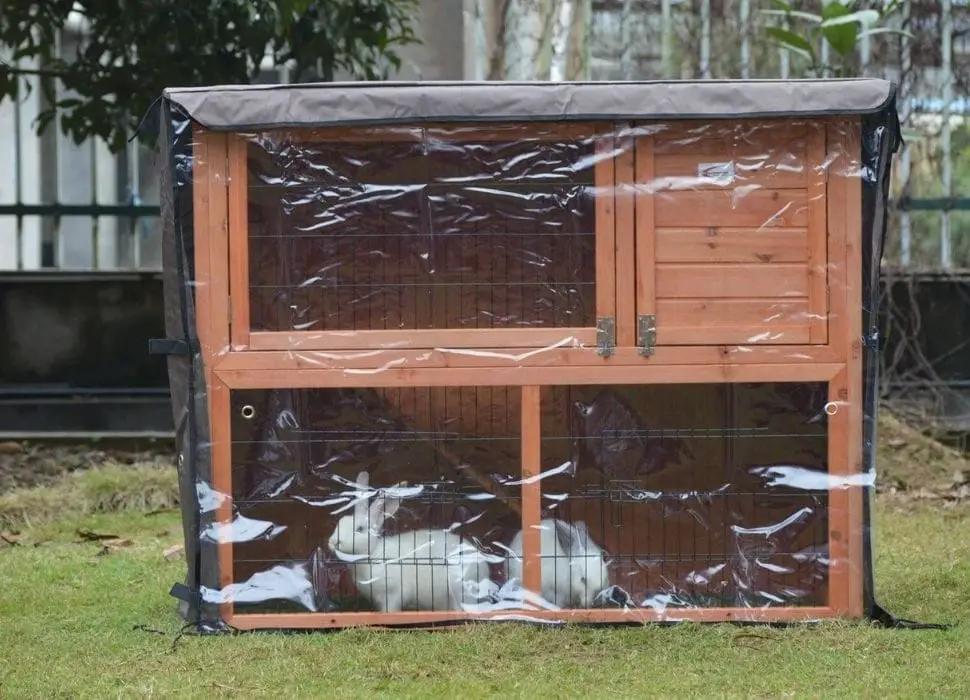As a rabbit owner, you’ve probably asked yourself, “How many hours a day should a rabbit be out of its cage?” It’s a simple question, but finding the right answer isn’t as straightforward as it may seem.
The ideal time a rabbit should be out of its cage ranges from 3 to 5 hours daily. This, however, should be divided into several shorter periods throughout the day, rather than one long stretch.
Introduction
Why does this matter so much? Well, your bunny isn’t just any pet. Rabbits are intelligent and active creatures. They need time outside their cage to exercise, explore, and satisfy their natural curiosity. Too little time outside the cage can lead to physical health problems and behavioral issues.
A Heated Debate
But opinions on this topic vary widely. Some people argue for more hours, some for fewer. You’ll find rabbit forums buzzing with heated debates and contrasting views. We are here to cut through the noise and give you a comprehensive, research-backed answer.

A Journey into the World of Rabbits
So, let’s embark on this journey together, to understand what makes a bunny tick and how to ensure your furry friend gets the right balance of cage time and freedom.
We’ll explore the science, consider the different factors that could influence your decision, and provide practical advice to create a safe and engaging environment for your rabbit outside its cage.
We understand that every rabbit is unique, and there’s no one-size-fits-all solution. But with the right knowledge, you can make an informed decision that best suits your bunny’s needs.
Understanding Rabbit Behavior
Rabbits, by nature, are highly active, curious, and full of energy. In their natural habitats, they’re consistently on the move, foraging for food, exploring their surroundings, and on the lookout for any potential predators.
This instinctual behavior is inherent and doesn’t simply disappear when they’re brought into a domestic setting. It’s therefore essential to replicate this active lifestyle as much as possible within your home.
Activity Peaks
Rabbits are crepuscular creatures, meaning they tend to be most active during the early morning and late evening hours.
This isn’t just a random preference. In the wild, these periods offer the best balance between visibility for foraging and safety from predators, most of whom are active during the day or night.
When considering how much time your rabbit should spend out of its cage, it’s beneficial to align this with its natural activity peaks.
Burrowers at Heart
Rabbits are instinctual diggers and burrowers. In the wild, they create extensive burrow systems, known as warrens, for safety and nesting purposes.
This instinctive behavior provides them with physical exercise and mental stimulation. While you may not want your rabbit digging up your carpet or backyard, providing safe alternatives like dig boxes or tunnel toys can satisfy this natural urge.
Social Butterflies
In their natural habitats, rabbits live in groups and form complex social structures. They communicate, groom each other, and form close bonds with their peers.
When living alone, rabbits can easily become lonely and depressed. So, in addition to providing time out of the cage, it’s important to ensure they have plenty of social interaction.
This can be with other rabbits (if properly introduced and bonded), or with you, their human caretaker.
The Need for Stimulation
Rabbits are intelligent animals, and like us, they need mental stimulation to thrive. An environment that offers a variety of textures, smells, and challenges can help keep your rabbit mentally engaged.

This could be achieved by introducing toys, puzzles, and new harmless objects for them to explore. The time they spend out of their cage is an ideal opportunity for this kind of enrichment.
Tying it Together
Understanding these key aspects of rabbit behavior offers us valuable insights into what they need to lead a fulfilling and healthy life.
It’s clear that rabbits are not meant to be confined all day. They need time to stretch their legs, socialize, and explore.
As we move forward, we’ll use this understanding to better answer the question: ‘How many hours a day should a rabbit be out of its cage?’ and to discuss how to make the most of this time.
What Science Says
Science provides us with some tangible parameters when it comes to our pets’ exercise needs. For rabbits, studies suggest that they should get at least three hours of exercise per day.
This comes from observing their wild counterparts, who spend a large portion of their time foraging and exploring. This activity not only keeps their bodies fit but also their minds stimulated.
The Importance of Space
Research also emphasizes the importance of space for rabbits. A study conducted by the University of Bristol found that rabbits housed in smaller, cramped conditions showed more signs of stress and poor health.
So, it’s not just about the time outside the cage, but also about the quality of space inside and outside the cage.
The Impact of Enrichment
Enrichment activities are another significant aspect backed by science. A research paper published in the Journal of Applied Animal Welfare Science found that environmental enrichment improved rabbits’ welfare significantly.
This means providing things like toys, digging opportunities, and hiding places can greatly enhance your rabbit’s quality of life.
Age and Health Considerations
Remember, however, that like humans, rabbits’ needs will change as they age and depending on their health status.
Older or less mobile rabbits may not require or be able to handle as much exercise. Always consult with your vet to understand the specific needs of your pet.
A Science-Backed Approach
Taking a science-backed approach to pet care ensures that we’re meeting our furry friends’ needs as closely as possible.
Research provides us with an understanding of rabbits’ natural behaviors and their basic needs for exercise, space, and enrichment.
By incorporating these findings into our pet care routines, we can ensure our rabbits lead healthier, happier lives.
In the following sections, we’ll use these insights to discuss in detail the answer to our key question: ‘How many hours a day should a rabbit be out of its cage?’ and to offer practical tips for enriching your rabbit’s out-of-cage time.
How Many Hours a Day Should a Rabbit be Out of its Cage?
After considering rabbit behavior and scientific research, we can now confidently answer our main question: ‘How many hours a day should a rabbit be out of its cage?’
Ideally, your rabbit should spend between 3 to 5 hours outside its cage each day.

Quality Over Quantity
However, it’s not just about ticking off hours on a clock. The quality of the time your rabbit spends outside the cage is just as important, if not more so, than the quantity.
This time should allow for exercise, exploration, social interaction, and mental stimulation.
Timing is Everything
Because rabbits are crepuscular, the timing of these out-of-cage periods is also crucial.
Aligning them with your rabbit’s natural activity peaks – early morning and late evening – can help ensure your pet gets the most benefit from this time.
Divide and Conquer
Rather than one long stretch, it’s recommended to break up the out-of-cage time into several shorter periods throughout the day.
This approach can help prevent your rabbit from becoming overly tired and provides multiple opportunities for exercise and stimulation.
Flexibility is Key
Keep in mind that these guidelines aren’t set in stone. Each rabbit is unique, with its own personality and preferences.
Some rabbits may desire more out-of-cage time, while others may be content with less. Always observe your rabbit’s behavior and adjust accordingly.
Applying these guidelines thoughtfully will help ensure your rabbit gets the right balance of freedom and security, promoting better physical health and mental well-being.
As we move forward, we’ll explore the various factors that could influence your rabbit’s out-of-cage time and provide practical advice on creating a safe and engaging environment for your rabbit outside the cage.
Factors Influencing Out-of-Cage Time
Younger, more active rabbits may require more out-of-cage time than older or less mobile rabbits. Similarly, a rabbit with health conditions might have different requirements.
Always consult with your vet to understand the specific needs of your pet.
Your Rabbit’s Personality
Each rabbit has a unique personality. Some may be more adventurous and active, requiring more time to explore and play.
Others might be more laid-back and content with less time outside the cage. Pay attention to your rabbit’s behavior and adjust the out-of-cage time accordingly.
The Size of the Cage
If your rabbit’s cage is spacious, providing plenty of room for movement and play, it might be less urgent for them to spend lots of time outside the cage.
On the other hand, a smaller cage might necessitate more out-of-cage time for your rabbit to stretch its legs and explore.
Your Home Environment
If your home environment is rabbit-proofed and safe, your rabbit may be able to spend more time outside the cage.

Conversely, if there are hazards or areas of the home that aren’t suitable for a rabbit, this might limit the time they can safely be out of their cage.
Your Schedule
Lastly, your own schedule will play a role. If you work from home or have a flexible schedule, it might be easier to provide your rabbit with frequent out-of-cage time.
If your schedule is more rigid, you’ll need to plan carefully to ensure your rabbit gets the necessary exercise and stimulation.
In considering these factors, you can tailor an out-of-cage schedule that best fits your rabbit’s needs and your personal circumstances.
In our next section, we’ll share some practical tips on how to create an engaging and safe environment for your rabbit when they’re out of their cage.
The Role of Supervised Playtime
While out-of-cage time is crucial for your rabbit, it’s equally important that this time is safe. Supervised playtime allows you to keep an eye on your rabbit and prevent any potential accidents or mishaps.
It’s not about monitoring their every move, but rather about ensuring their environment is free from hazards.
Bonding Time
Supervised playtime isn’t just about safety, though. It’s also a wonderful opportunity for you and your rabbit to bond.
Whether it’s through gentle petting, playing with toys together, or simply sitting near each other, these interactions can strengthen the bond between you and your furry friend.
Active Engagement
During supervised playtime, try to engage with your rabbit actively. This could mean setting up new toys or challenges for them, introducing new harmless items for them to explore, or participating in their play.
Active engagement can provide the mental stimulation your rabbit craves and make their out-of-cage time more enriching.
Understanding Their Behavior
Supervised playtime also provides a great opportunity to better understand your rabbit’s behavior.
Observing them during their active periods can give you insights into their preferences, habits, and any potential health issues.
For instance, changes in activity levels, eating habits, or litter habits can be early indicators of health problems.
The Balance of Supervision
It’s all about striking the right balance. While supervision is important for safety and engagement, it’s also essential to give your rabbit some space and independence.
Rabbits are naturally curious and enjoy exploring their surroundings on their own.
Incorporating supervised playtime effectively into your rabbit’s routine can significantly enhance their out-of-cage experience. It ensures their safety, promotes bonding, and provides enriching mental and physical stimulation.
As we delve into the final part of our discussion, we’ll be providing you with practical tips and tricks to make your rabbit’s out-of-cage time as beneficial and enjoyable as possible.
The Safe Space: Rabbit-Proofing Your Home
When rabbit-proofing your home, try to see things from your pet’s perspective. Rabbits are curious and love to explore, chew, and dig.
They’ll often find the most unexpected places and items interesting. So, it’s important to ensure that nothing harmful is within their reach.
Protect Your Belongings
Rabbits are notorious chewers. Electrical cords, furniture legs, carpets, and house plants can all fall victim to a rabbit’s teeth.
Use cord protectors, keep valuable items out of reach, and choose houseplants that are non-toxic to rabbits to protect both your belongings and your rabbit.

Limit Access to Certain Areas
Consider installing baby gates or pens to limit your rabbit’s access to certain areas of your home. This can be especially useful if you have other pets, if there are rooms with many hazards, or if you’re unable to supervise your rabbit closely at all times.
Make it Comfortable
Ensure that the areas your rabbit has access to are comfortable and rabbit-friendly. This could mean providing soft rugs for traction on slippery floors, offering shady spots for your rabbit to rest, and ensuring the room temperature is comfortable for your pet.
Provide Enrichment Opportunities
Rabbit-proofing isn’t just about safety. It’s also about creating an environment that encourages natural rabbit behaviors like exploring, foraging, and digging.
Providing toys, tunnels, digging boxes, and other enrichment opportunities can make your rabbit’s out-of-cage time more enjoyable and stimulating.
Rabbit-proofing your home is a crucial step in ensuring your rabbit’s out-of-cage time is safe and rewarding.
By understanding your rabbit’s perspective and taking steps to protect both your pet and your belongings, you can create an environment that’s conducive to your rabbit’s well-being and happiness.
Let’s move forward now and explore how you can further enhance your rabbit’s out-of-cage experience with toys and enrichment activities.
The Risks of Too Much Cage Time
Rabbits are active animals, and prolonged confinement can lead to a host of physical health issues. Lack of exercise can result in obesity, a risk factor for numerous other health problems including heart disease and arthritis.
Mental Health Effects
Beyond the physical implications, there are mental health effects too. Rabbits are intelligent creatures that require mental stimulation. Spending too much time in a cage can lead to boredom, frustration, and depression.
Behavioural Problems
Extended cage time can also result in behavioural problems. Bored rabbits may develop harmful habits such as over-grooming, resulting in fur loss and skin irritation, or bar chewing, which can damage their teeth.
Lack of Social Interaction
Rabbits are social animals. Being confined to a cage can limit their interactions with you and any other pets in the household.
This lack of social interaction can lead to loneliness and further exacerbate mental health issues.
Hindrance to Natural Behavior
Lastly, too much cage time hinders your rabbit’s ability to exhibit natural behaviors like hopping, exploring, and foraging.
These behaviors are not only crucial for your rabbit’s physical health, but also for their overall well-being and happiness.
It’s clear that while a cage provides a safe haven for your rabbit, spending too much time inside can have detrimental effects.
It’s about achieving a balance that caters to your rabbit’s need for safety, exercise, mental stimulation, and social interaction.
Let’s delve into our final section, where we’ll discuss toys and enrichment activities that can make your rabbit’s out-of-cage time truly rewarding.
Conclusion
Caring for a rabbit is a fulfilling journey, one filled with joy, companionship, and sometimes, challenges. One of the most crucial components of rabbit care is understanding and catering to their need for out-of-cage time.
The exact number of hours a rabbit should be out of its cage varies, depending on their age, health, and personality.
It’s influenced by factors like the size of the cage, the safety of your home environment, and your own schedule.
Remember, it’s not just about the quantity, but also the quality of out-of-cage time. Supervised playtime, rabbit-proofing your home, and providing enrichment opportunities can make this time more rewarding for your rabbit.
Understanding the risks associated with too much cage time can further emphasize the importance of striking the right balance.
With careful observation and a deep understanding of your rabbit’s needs, you can create a routine that keeps your furry friend happy, healthy, and active.
We hope that this guide has helped shed some light on outside time for your own rabbit. As you navigate your rabbit care journey, remember that every rabbit is unique.
What works for one might not work for another. Always pay attention to your rabbit’s behavior and adjust your routine as needed. Your rabbit’s health, happiness, and well-being are worth it.

Frequently Asked Question
How many hours a day should you spend with your pet rabbit?
Spending at least 2-3 hours a day with your pet rabbit is recommended for social interaction, exercise, and mental stimulation.
Can I let my bunny run around the house?
Yes, you can let your bunny run around the house, but ensure it’s a safe and bunny-proofed environment with no hazards or access to chewable items.
Should I let my bunny free roam in my room?
You can let your bunny free roam in your room if it’s bunny-proofed and safe. Supervise to prevent chewing on wires or furniture.
Do rabbits like to go on walks?
Most rabbits are not suited for walks like dogs, as they are prey animals. However, supervised outdoor time in a secure area can be enjoyable for them.
Do rabbits have a bedtime?
Rabbits are crepuscular animals, meaning they are most active during dawn and dusk. They don’t have a specific bedtime but adapt to their environment’s light/dark cycle.

